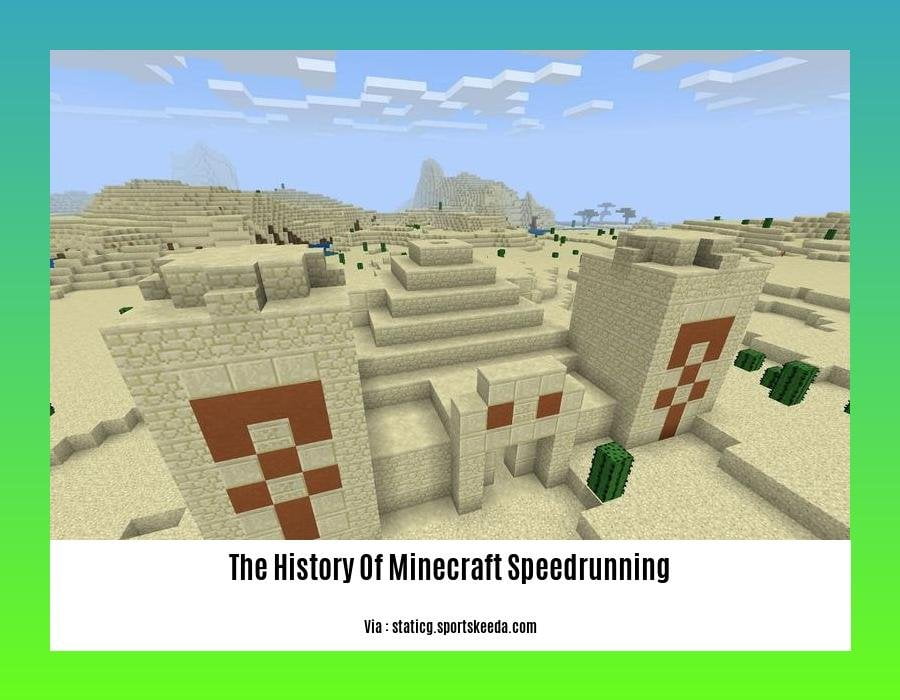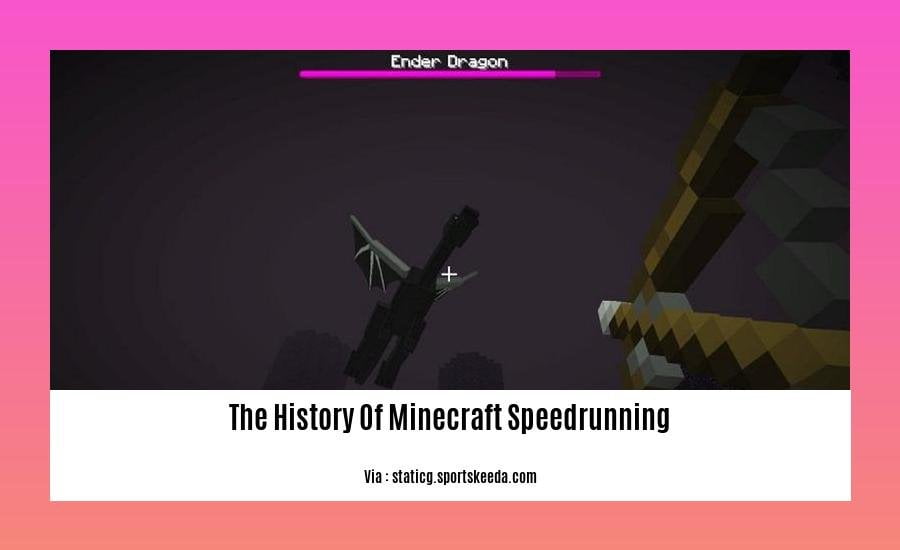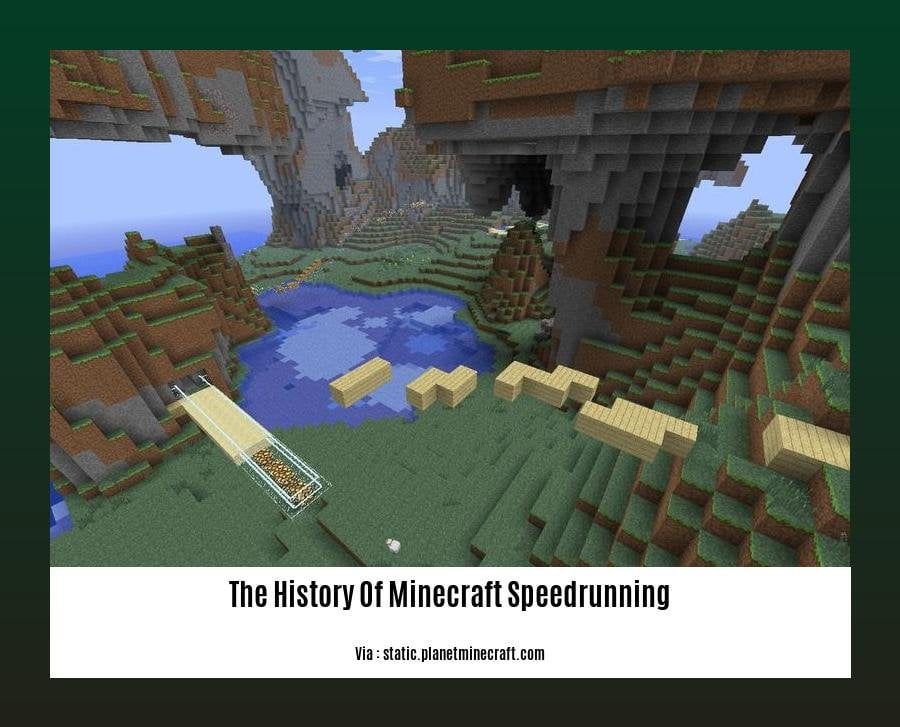The History of Minecraft: From Humble Beginnings to World Dominance
Key Takeaways:
- Minecraft speedrunning: Completing the game as quickly as possible in various categories.
- Categories: Any% Glitchless (no exploits), Any% (exploits allowed).
- Popularity surged in the 2010s due to the game’s popularity and definitive ending.
- World records exist for different categories.
- Any% Glitchless – Random Seed: Strive for sub-17 minute completion times, evidence required.
The History of Minecraft Speedrunning

Minecraft Speedrunning is like a high-stakes race against the clock where players aim to complete the game as swiftly as possible. It all began in the mid-2010s when Minecraft’s popularity skyrocketed. With a definitive end goal – defeating the mighty Ender Dragon – the speedrunning community was born.
Two main categories emerged: Any% Glitchless (no exploiting in-game glitches) and Any% (anything goes). The latter is a wild west of creativity, where runners push the game’s boundaries.
Speedrunning captivated the gaming world, and soon, world records were set and broken with astonishing regularity. The Any% Glitchless – Random Seed category became a popular battleground, where runners aimed for sub-17 minute times.
Today, Minecraft speedrunning is a thriving subculture with dedicated communities and tournaments. It’s a testament to the game’s replayability and the human desire to conquer challenges in the most audacious ways.
To learn about the development and evolution of Minecraft, including significant updates, the introduction of villagers, and the intriguing mystery of Herobrine, read the history of Minecraft.
Explore the history of Minecraft updates to see how the game has changed over time, from its humble beginnings to its current state as a global phenomenon.
Discover the history of Minecraft villagers and how their role has evolved from simple traders to complex villagers with their own AI and behaviors.
Uncover the history of Minecraft Herobrine, a mysterious and elusive figure that has captivated the imaginations of Minecraft players for years.
Delve into the history of Minecraft war and learn about the epic conflicts and battles that have shaped the game’s world.
Navigate the history of Minecraft timeline to trace the chronological development of the game, from its inception to its present form.
Explore the history of Minecraft mobs to learn about the diverse creatures that inhabit the game world, from friendly animals to formidable foes.
Investigate the history of Minecraft pillagers and discover the origins and behaviors of these hostile raiders that pose a threat to players and villagers alike.
Discover the history of Minecraft skins and how they have evolved to express players’ individuality and creativity within the game.
Game-Changing Strategies and Techniques in Minecraft Speedrunning
Minecraft speedrunning has witnessed a surge in popularity, with players continually discovering innovative strategies to shave off precious seconds from their runs. Here are a few game-changing techniques that have revolutionized the meta:
Pathfinding Optimization
Instead of meticulously following a predetermined route, speedrunners have devised optimized paths that exploit the game’s terrain generation. By analyzing the seed and leveraging skips and glitches, they can traverse the world more efficiently and locate critical resources faster.
In-Game Mechanics Manipulation
Speedrunners have mastered the art of manipulating in-game mechanics to their advantage. Techniques like “water clutching” and “ender pearl boosting” allow them to navigate obstacles and gain momentum, shaving off significant time. Additionally, they exploit TNT cannons and bed explosions to bypass large sections of the world.
Resource Management
Resource management is crucial in speedrunning. Players carefully plan their item and food consumption, optimizing their inventory space for essential gear. Techniques like “hogging” and “lava trapping” enable them to acquire essential resources efficiently.
Key Takeaways:

- Pathfinding optimization involves leveraging skips, glitches, and seed analysis.
- In-game mechanics manipulation includes water clutching, ender pearl boosting, and TNT cannons.
- Resource management strategies focus on item and food optimization and employing techniques like hogging and lava trapping.
Citations:
- Minecraft Speedrunning Guide: Strategies and Techniques
- How to Speedrun Minecraft: Tips and Tricks
Sub-Categories and Rules
Minecraft speedrunning can be divided into various categories and subcategories, each with its rules and restrictions.
There are three main categories of Minecraft speedruns:
- Any%: As fast as possible, using any methods or glitches.
- Glitchless%: As fast as possible, without using glitches, bugs or exploits.
- 100%: Complete all game objectives, including finding all achievements.
Each main category is consists of various subcategories, such as:
- Any% Glitchless: A popular subcategory focusing on completing the game as quickly as possible without using glitches.
- Any% Random Seed: Using a random seed, or world generation number, to start the game, adding an element of unpredictability.
- 100% Random Seed: Completing the game with all objectives using a random seed.
Key Takeaways:
- Minecraft speedrunning encompasses a range of categories and subcategories, each with specific rules and restrictions.
- The main categories are Any%, Glitchless%, and 100%.
- Subcategories add variety and challenge, such as Any% Glitchless, Any% Random Seed, and 100% Random Seed.
Citations:
Impact on the Minecraft Community and Beyond
The impact of Minecraft speedrunning reaches far beyond its devoted community. It has revolutionized the way games are played and inspired the creation of new strategies and techniques. Here’s how:
Increased Minecraft’s Replayability: Speedrunning has breathed new life into Minecraft, transforming it from a simple survival game into an exhilarating competitive platform.
Boosted Minecraft’s Popularity: With streamers and content creators showcasing mind-boggling speedrunning feats, it has attracted a wider audience, boosting the game’s overall popularity.
Inspired Game Developers: Speedrunning has become a valuable tool for game developers to identify glitches and inefficiencies, leading to game updates that improve performance and overall gameplay.
Bridged Communities: The shared passion for speedrunning has created a global community of players who collaborate, share strategies, and push each other’s limits.
Key Takeaways:
- Minecraft speedrunning has significantly increased the game’s replayability.
- It has boosted Minecraft’s overall popularity.
- Speedrunning has inspired game developers to improve gameplay.
- It has bridged gaps between gaming communities.
Relevant URL Sources:
FAQ
Q1: When did Minecraft speedrunning begin?
A1: The origins of Minecraft speedrunning can be traced back to the game’s early days in 2011.
Q2: Who is considered the first Minecraft speedrunner?
A2: The identity of the first Minecraft speedrunner is not definitively known, but several players are credited with pioneering the activity in its early stages.
Q3: What was the first major milestone in Minecraft speedrunning history?
A3: One of the earliest significant milestones was the achievement of a sub-16-minute completion time in the Any% category in 2013.
Q4: How have speedrunning techniques evolved over time?
A4: Minecraft speedrunning techniques have continuously evolved, with runners discovering new glitches, optimizing strategies, and utilizing technological advancements to improve their times.
Q5: What is the current state of Minecraft speedrunning?
A5: Minecraft speedrunning remains a popular and competitive activity, with ongoing advancements and world record-breaking performances.
- Crypto Quotes’ Red Flags: Avoid Costly Mistakes - June 30, 2025
- Unlock Inspirational Crypto Quotes: Future Predictions - June 30, 2025
- Famous Bitcoin Quotes: A Deep Dive into Crypto’s History - June 30, 2025
















